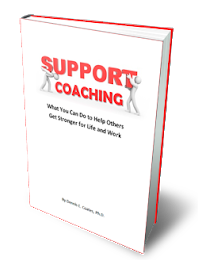The same holds true for developing the personal strengths you need to handle the tough situations you face every day in your work and life. You can take a course, read books by the world’s best experts and watch videos by the most inspiring speakers, but until you apply this “head” knowledge in the real world, you won’t get stronger as a person.
The real test is: What will you do when you’re in a situation and you have to use a specific strength?
Most likely you’ll do what’s comfortable and automatic. You’ll use the habit you’ve developed over a period of years.
When you’re in the “thick” of it, you usually don’t have time to think consciously about the best way to handle the situation. Maybe you’re under the pressure of time or you’re so uncomfortable you just want to get through the moment and move on. At times like this, you’re not likely to think about the latest book you read or be able to remember the specific idea you wanted to apply in the future.
No, here’s what happens: You act in a way that’s consistent with what you’ve done in the past.
There’s a reason for this, and it has to do with what’s been happening in your brain over time. As you repeat a specific behavior pattern, your brain cells connect into a physical circuit. The more you repeat that behavior, the stronger the connections become. Eventually you’ve got the equivalent of a superhighway, so you’re able to perform that action automatically, without having to think about it. It’s now hard-wired in your brain.
When you read about or watch how to do something that’s different from your current pattern, you don’t automatically form a new circuit in your brain. Performing the behavior is what forms the brain cell connections. You have to actually do the behavior – translate the idea into action.
Some examples:
Decisiveness – Maybe your pattern is to delay until you gather all the facts and consider every potential downside. You’ll find it very uncomfortable to move forward if a quick decision is needed in order to take advantage of a unique opportunity.
Intuition – If you’re in the habit of analyzing everything by the numbers, you will not instantly start trusting what your gut is telling you.
Responsibility – When you're used to blaming circumstances or other people for your failures and problems, you won't find it easy to examine your own thoughts, attitudes and actions that may have been contributing factors.
In each of these scenarios – and dozens of others – knowing what you need to do is not enough. You have to actually step outside your comfort zone and DO something different. Not just once or twice. But dozens and even hundreds of times, if you want the new behavior to become your automatic response in a given situation.
PRACTICE and REPETITION are the keys to establishing strong circuits in your brain. Just ask any top performers in any field - from musicians to athletes to entrepreneurs. They’ve typically invested thousands of hours to mastering their area of genius.
If you're serious about your own development, I encourage you to check out ProStar Coach. This online virtual coaching system helps you rewire your brain for becoming stronger as a person so you're better prepared to deal with the inevitable challenges life brings your way.






No comments:
Post a Comment
Note: Only a member of this blog may post a comment.